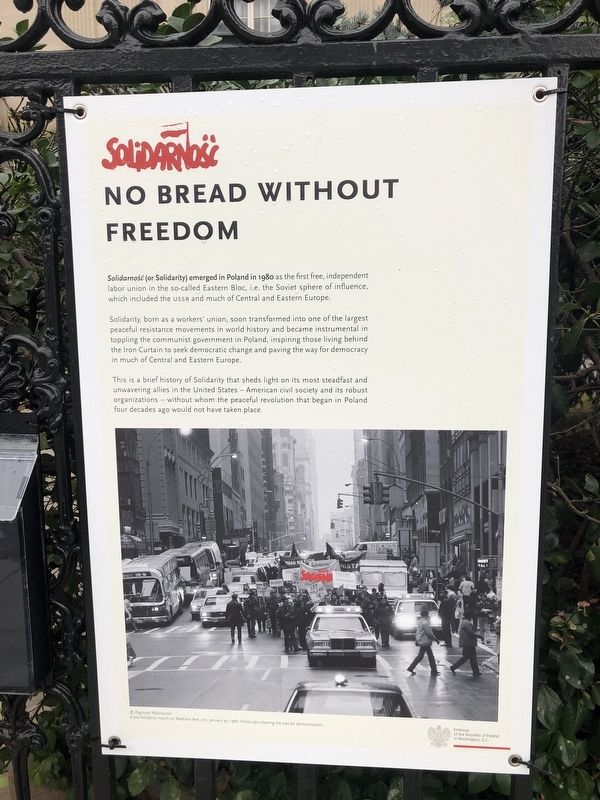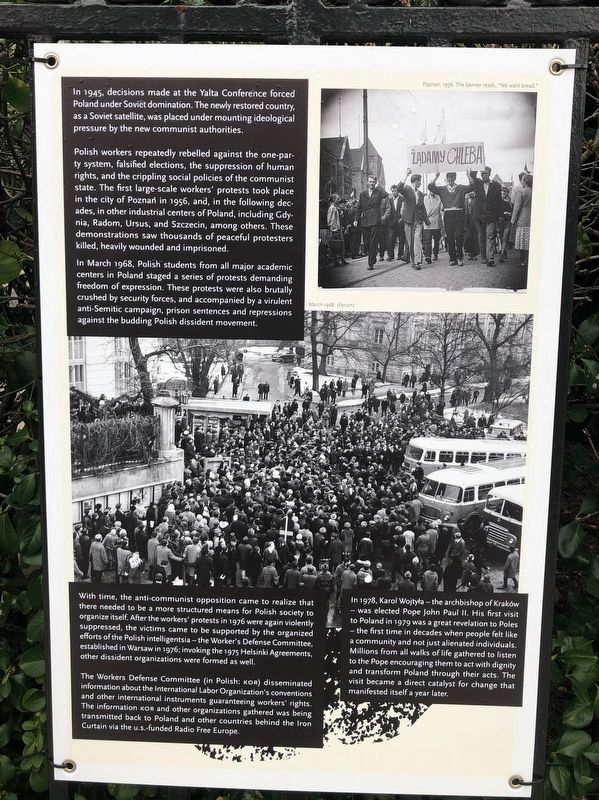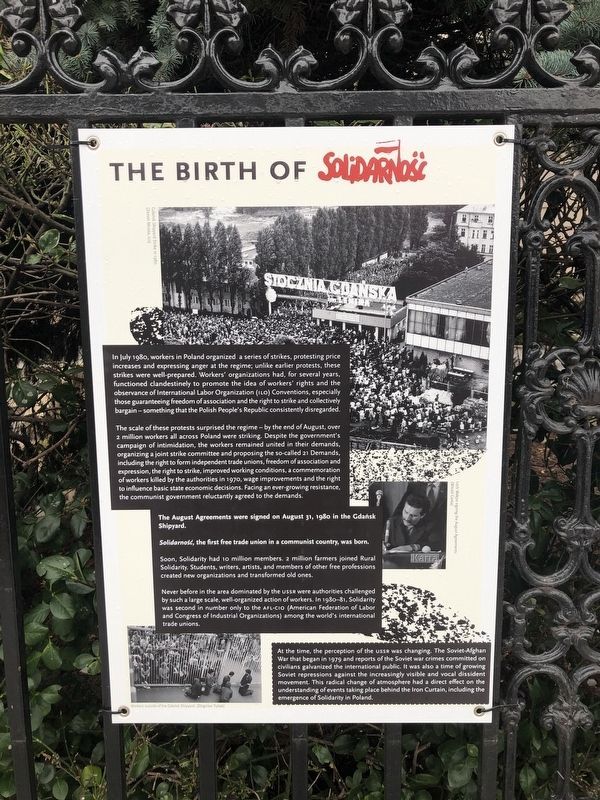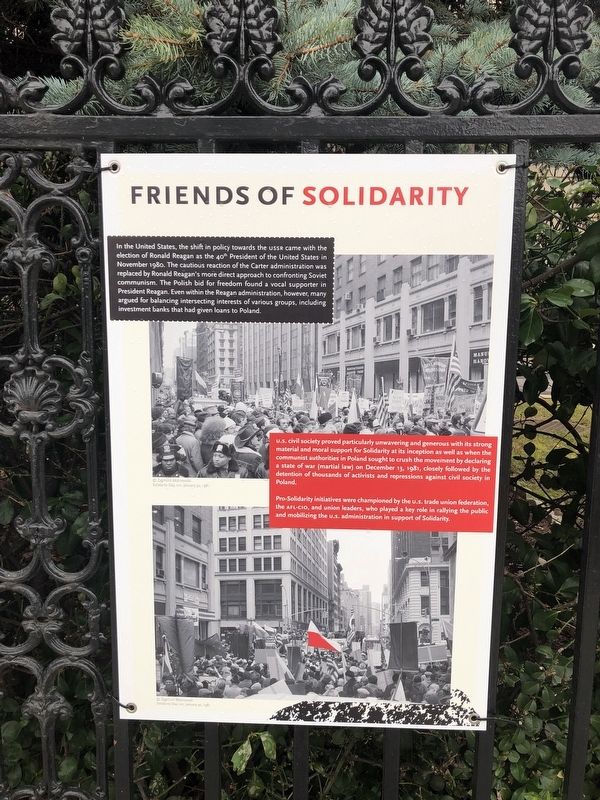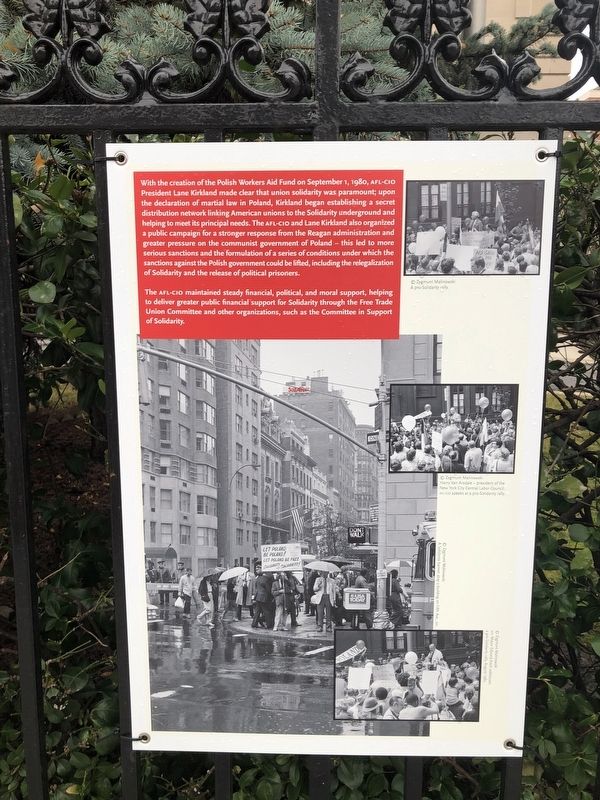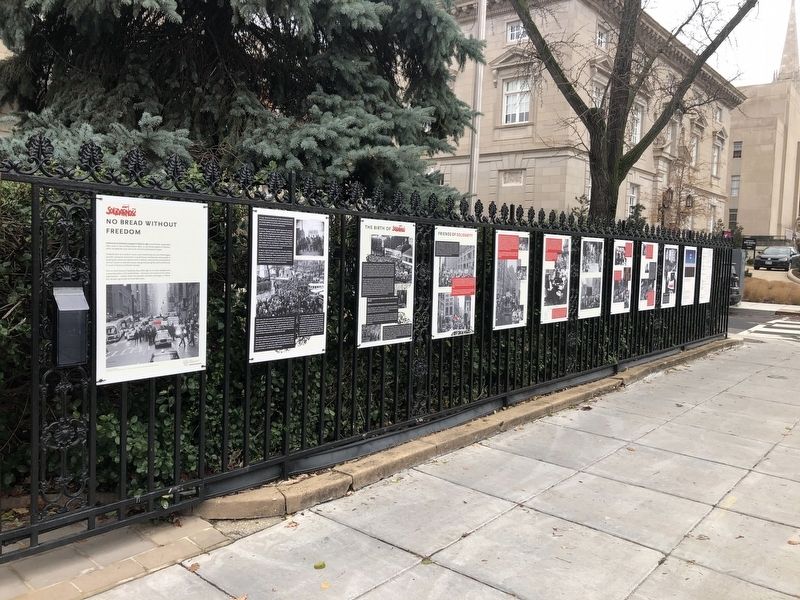Adams Morgan in Northwest Washington in Washington, District of Columbia — The American Northeast (Mid-Atlantic)
Solidarność
No Bread Without Freedom
Solidarność (or Solidarity) emerged in Poland in 1980) as the first free, independent labor union in the so-called Eastern Bloc, i.e. the Soviet sphere of influence, which included the USSR and much of Central and Eastern Europe.
Solidarity, born as a workers' union, soon transformed into one of the largest peaceful resistance movements in world history and became instrumental in toppling the communist government in Poland, inspiring those living behind the Iron Curtain to seek democratic change and paving the way for democracy in much of Central and Eastern Europe.
This is a brief history of Solidarity that sheds light on its most steadfast and unwavering allies in the United States — American civil society and its robust organizations — without whom the peaceful revolution that began in Poland four decades ago would not have taken place.
In 1945, decisions made at the Yalta Conference forced Poland under Soviet domination. The newly restored country, as a Soviet satellite, was placed under mounting ideological pressure by the new communist authorities.
Polish workers repeatedly rebelled against the one-party system, falsified elections, the the suppression of human rights, and the crippling social policies of the communist state. The first large-scale workers' protests took place in the city of Poznań in 1956, and, in the following decades, in other industrial centers of Poland, including Gdynia, Radom, Ursus, and Szczecin, among others. These demonstrations saw thousands of peaceful protesters killed, heavily wounded and imprisoned.
In March 1968, Polish students from all major academic centers in Poland staged a series of protests demanding freedom of expression. These protests were also brutally crushed by security forces, and accompanied by a virulent anti-Semitic campaign, prison sentences and repressions against the budding Polish dissident movement.
With time, the anti-communist opposition came to realize that there needed to be a more structured means for Polish society to organize itself. After the workers' protests in 1976 were again violently suppressed, the victims came to be supported by the organized efforts of the Polish intelligentsia — the Worker's Defense Committee, established in Warsaw in 1976; invoking the 1975 Helsinki Agreements, other dissident organizations were formed as well.
The Workers Defense Committee (in Polish: KOR) disseminated information about the International Labor Organization's conventions and other international instruments guaranteeing workers' rights. The information KOR and other organizations gathered was being transmitted
In 1978, Karol Wojtyła — the archbishop of Kraków — was elected Pope John Paul II. His first visit to Poland in 1979 was a great revelation to Poles — the first time in decades when people felt like a community and not just alienated individuals. Millions from all walks of life gathered to listen to the Pope encouraging them to act with dignity and transform Poland through their acts. The visit became a direct catalyst for change that manifested itself a year later.
The Birth of Solidarność
In July 1980, workers in Poland organized a series of strikes, protesting price increases and expressing anger at the regime; unlike earlier protests, these strikes were well-prepared. Workers' organizations had, for several years, functioned clandestinely to promote the idea of workers' rights and the observance of International labor Organization (ILO) Conventions, especially those guaranteeing freedom of association and the right to strike and collectively bargain — something that the Polish People's Republic consistently disregarded.
The scale of these protests surprised the regime — by the end of August, over 2 million workers all across Poland were striking Despite the government's campaign of intimidation,
The August Agreements were signed on August 31, 1980 in the Gdańsk Shipyard.
Solidarność, the first free trade union in a communist country, was born.
Soon, Solidarity had 10 million members. 2 million farmers joined Rural solidarity. Students, writers, artists, and members of other free professions created new organizations and transformed old ones.
Never before in the area dominated by the USSR were authorities challenged by such a large scale, well-organized action of workers. In 1980-81, Solidarity was second in number only to the AFL-CIO (American Federation of Labor and Congress of Industrial Organizations) among the world's international trade unions.
At the time, the perception of the USSR was changing. The Soviet-Afghan War that began in 1979 and reports
Friends of Solidarity
In the United States, the shift in policy towards the USSR came with the election of Ronald Reagan as the 40th President of the United States in November 1980. The cautious reaction of the Carter administration was replaced by Ronald Reagan's more direct approach to confronting Soviet communism. The Polish bid for freedom found a vocal support in President Reagan. Even within the Reagan administration, however, many argued for balancing intersecting interests of various groups, including investment banks that had given loans to Poland.
U.S. civil society proved particularly unwavering and generous with its strong material and moral support for Solidarity at its inception as well as when the communist authorities in Poland sought to crush the movement by declaring a state of war (martial law) on December 13, 1981, closely followed by the detention of thousands of activists and repressions against civil society
Pro-Solidarity initiatives were championed by the U.S. trade union federation, the AFL-CIO, and union leaders, who played a key role in rallying the public and mobilizing the U.S. administration in support of Solidarity.
With the creation of the Polish Workers Aid Fund on September 1, 1980, AFL-CIO President Lane Kirkland made clear that union solidarity was paramount; upon the declaration of martial law in Poland, Kirkland began establishing a secret distribution network linking American unions to the Solidarity underground and helping to meet its principal needs. The AFL-CIO and the Lane Kirkland also organized a public campaign for a stronger response from the Reagan administration and greater pressure on the communist government of Poland — this led to more serious sanctions and the formulation of a series of conditions under which the sanctions against the Polish government could be lifted, including the relegalization of Solidarity and the release of political prisoners.
The AFL-CIO maintained steady financial, political, and moral support, helping to deliver greater public financial support for Solidarity through the Free Trade Union Committee and other organizations, such as the Committee in Support of Solidarity.
Public opinion
Protests against the repressions in Poland attracted top representatives of municipal authorities, defenders of human rights, and large and committed groups of political refugees from other communist countries, including Czechoslovakia, Ukraine, Latvia, Lithuania, Estonia, Afghanistan and Cuba.
Many artists and public intellectuals joined in. At a pro-Solidarity rally in Manhattan, Susan Sontag — an icon of the intellectual left — declared communism to be morally and politically bankrupt, chastising intellectuals who refused to take a public position against the persecution of oppositionists and bloodletting that had gone on from Poland to Cuba to Cambodia. Joan Baez — a legendary folk singer and an icon of civil rights and peace movements — visited Poland to express her support for Solidarity.
Lane Kirkland (1922-1999), the president of the American federation of unions, the AFL-CIO. Kirkland helped organize international support for an American-led boycott of Polish shipping in order to pressure the Polish government to negotiate the Gdańsk Agreements on August 31, 1980. Under Kirkland, the AFL-CIO supplied money, fax machines, radios and computers to Solidarity and other free unions in communist countries. He relied on a small cadre of dedicated assistants who shared his passion for the cause; Tom Kahn coordinated the undertaking.
For reliable information from inside martial-law Poland, Kirkland worked with the Committee in Support of Solidarity, whose principal figures — Irena Lasota, a Polish émigré who came to the United States after facing persecution for her anti-regime involvement as a student, and Eric Chenoweth, a young political activist — had developed a wide range of contacts within the Solidarity structure.
Albert Shanker (1928-1997), an early activist in the civil rights movement, lifelong social democrat, a staunch anti-communist, and president of the American Federation of Teachers (AFT). Shanker was engaged in the central struggles of his time for human and civil rights, workers' rights, and freedom. He was Ronald Reagan's opponent on domestic issues, but supported his opposition on communism. Under Shanker's leadership, the AFT supported a range of projects and actions aimed at strengthening trade unions and democracy movements, including in Solidarność. In 1988, Shanker was the first American trade union leader after the imposition of martial law to meet with underground Solidarity leaders in Poland.
Tom Kahn (1938-1992), an assistant to Lane Kirkland and former aide to civil rights leader Bayard Rustin. In 1980, Lane Kirkland appointed Kahn to organize the AFL-CIO's support for Solidarity. Kahn focused on winning financial and political support for the Polish workers through information dissemination, demonstrations and activities in the United States, purchasing and smuggling in materials needed by Solidarity — printing presses, typewriters, computers — and making sure that the U.S. administration (first Carter's then Reagan's) did not undermine the workers by lifting sanctions against Poland. Kahn was so successful in organizing aid for Solidarity that by 1984, both Democrats and Republicans agreed that the movement deserved to be supported openly. The AFL-CIO's public support was deemed exemplary and appropriate for a democracy — much more suitable than the clandestine CIA funding that had previously been funneled to Solidarity.
Bayard Rustin (1912-1987), a legend of the civil rights movement in the United States, one of Martin Luther King's closes collaborators, and the organizer of the 1963 March on Washington. Rustin worked to strengthen the labor movement, which he saw as the champion of empowerment for the African-American community. He was the Director of the A. Philip Randolph Institute, which coordinated the AFL-CIO's work on civil rights and economic justice. Rustin was instrumental in organizing early support for Solidarity, particularly in New York. He traveled to Poland several times, including as a member of the U.S. Holocaust Commission, most notably in April 1981, where he met with leaders of a number of regional branches of Solidarity and with Lech Wałęsa, the leader of Solidarity.
The First National Congress of Solidarity in the fall of 1981 was a huge success for union democracy worldwide.
Trade unions in the free world supported Solidarity through a variety of means; equally as important, Solidarity inspired the creation of dissident free trade unions in the Soviet Union and Eastern Europe as well as beyond, in the Soviet Union and Eastern Europe as well as beyond, including Chile, South Africa and China. Today, four decades since the inception of Solidarity, we are yet to appreciate fully the impact and transformative role it played in Poland and around the world.
Jan Sawka, a Polish graphic artist, designed this poster, subsequently sold in the millions to provide immediate support to Solidarność. The button with the Solidarity logo as a sun above a landscape of crowd-like trees became an iconic image, immediately recognizable to supporters of the movement around the world.
Acknowledgements
We are particularly grateful to Ms. Irena Lasota and Mr. Eric Chenowith, formerly the Committee in Support of Solidarity, now the Institute for Democracy in Eastern Europe (IDEE), for their indispensible guidance and support in the process of preparing this exhibition, and for allowing us to peruse the organizations' photographic archives.
We also wish to thank Mr. Zygmunt Malinowski and the Polish Institute of Arts and Sciences of America (PIASA) for their permission to use their logo. The image of Jan Sawka's poster was used with the permission of the PIASA.
Author: Embassy of the Republic of Poland in Washington, D.C.
Graphic design: Marcin Zonenberg
[Timeline:]
1918
Poland reborn at the end of WWI.
1919-1921
The Polish-Bolshevik War; Poland stops the attempted invasion of its territory by the Soviet Army.
1939
The Ribbentrop-Molotov Pact between Nazi Germany and the Soviet Union is signed; in September 1939, both attack and invade Poland. The country remains under Nazi German occupation until the end of WWII.
1944
The creation of the Polish Committee in the USSR, under Soviet tutelage, to act as the new government of Poland.
1945
The Yalta Conference
The U.S., the U.K. and the USSR), agree that Poland will fall under the Soviet sphere of influence.
1956
Workers' uprising in Poznań, Poland; many participants killed and wounded.
The Hungarian Revolution is brutally suppressed by the USSR.
1968
Student protests at major Polish universities are suppressed, participants arrested; as a result of an anti-Semitic campaign launched by the communist government, many leave the country.
The Prague Spring — Soviet-led Warsaw Pact troops invade Czechoslovakia. 2,000 tanks and 200,000 troops strong, they crush the Czechoslovakian attempts at democratization, tightening the Soviet grip on the country.
1970
Workers peacefully protesting against price increases in major industrial centers, including Gdańsk, Szczecin, Gdynia, are met by army units; many are killed, arrested and fired.
1976
Workers protesting against price increases in Ursus, Radom and Płock are attacked by the police. Students and intellectuals organize to provide aid for the victims.
1978
Polish Cardinal Karol Wojtyła is elected Pope John Paul II.
1979
Pope John Paul II visits Poland.
The beginning of the Soviet-Afghan War.
1980
Strikes begin all over Poland; over 200 factories join in. On August 31, an agreement between the Interfactory Strike Committee and the communist government is signed, allowing for the creation of free and independent trade unions — Solidarność is born.
General Wojciech Jaruzelski becomes the Prime Minister of Poland in October and is elected the First Secretary of the Polish United Workers' Party (PZPR).
The Soviet newspaper "Pravda" publishes a message from Jaruzelski to Brezhnev, affirming the principles of Marxism-Leninism as a foundation for repelling "counterrevolutionary forces" in Poland. Joint Polish-Soviet maneuvers conducted in Poland.
September 1981, the first National Congress of Solidarity opens in Gdańk.
November 1981, student strikes spread throughout Poland, involving over 55,000 students who demand greater academic freedom.
At 6:00 AM on December 13, Polish television and radio broadcast Jaruzelski's speech declaring the imposition of a state of war (martial law). Security forces round up Solidarity leaders.
Strikes break out throughout Poland, demanding the end of martial law. Armed with tanks, machine guns, water cannons and gas canisters, army and special police forces break up the strikes.
December 16 — while suppressing the strike in the Wujek coal mine in Katowice, nine miners are shot dead, many others wounded and detained.
Ronald Reagan becomes the 40th President of the United States.
1982
Arrested Solidarity members are handed sentences of up to 8 years; over 3,000 people are sentenced to prison, over 10,000 are detained; over 100,000 fired from work. Hundreds are arrested and wounded in attacks by the police. Solidarity supporters demonstrate in defiance of the government; Solidarity delegalized.
1983
Martial law lifted.
Lech Wałęsa, the leader of Solidarity, is awarded the Nobel Peace Prize.
1985
The Perestroika ("restructuring") era begins in the USSR.
1988
A wave of strikes begins: workers, members of free professions and students join forces.
1989
Negotiations between Solidarity and the communist government begin, culminating in the first partially-free elections in over half of a century on June 4, 1989; an overwhelming victory for Solidarity.
The Berlin Wall falls on November 9, 1989.
Erected 2020 by The Embassy of the Republic of Poland.
Topics and series. This historical marker is listed in these topic lists: Civil Rights • Government & Politics • Labor Unions • War, Cold. In addition, it is included in the Former U.S. Presidents: #39 James Earl "Jimmy" Carter, Jr., and the Former U.S. Presidents: #40 Ronald Reagan series lists. A significant historical month for this entry is March 1968.
Location. This marker has been replaced by another marker nearby. It was located near 38° 55.479′ N, 77° 2.199′ W. Marker was in Northwest Washington in Washington, District of Columbia. It was in Adams Morgan. Marker was on 16th Street Northwest just south of Fuller Street Northwest, on the right when traveling south. Touch for map. Marker was in this post office area: Washington DC 20009, United States of America. Touch for directions.
Other nearby markers. At least 8 other markers are within walking distance of this location. Maria Czaplicka (here, next to this marker); Jacek Karpiński (here, next to this marker); Henryk Arctowski (here, next to this marker); Rudolf Weigl (here, next to this marker); Ignacy Łukasiewicz (here, next to this marker); Zofia Kielan-Jaworowska (here, next to this marker); Ernest Malinowski (here, next to this marker); Maria Skłodowska Curie (here, next to this marker). Touch for a list and map of all markers in Northwest Washington.
Also see . . . Solidarność Marker Additional Photos. Google Drive folder of images of additional plaques on the display. (Submitted on December 25, 2020, by Devry Becker Jones of Washington, District of Columbia.)
Additional keywords. LGBT, LGBTQ, Bayard Rustin, 🏳️🌈
Credits. This page was last revised on January 30, 2023. It was originally submitted on December 25, 2020, by Devry Becker Jones of Washington, District of Columbia. This page has been viewed 162 times since then and 18 times this year. Photos: 1, 2, 3, 4, 5, 6. submitted on December 25, 2020, by Devry Becker Jones of Washington, District of Columbia.
